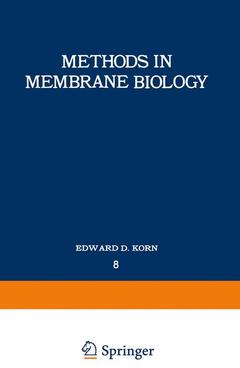Methods in Membrane Biology, Softcover reprint of the original 1st ed. 1977 Volume 8
Langue : Anglais
Auteur : Korn Edward D.

Although not the only volume in this series in which lipids are discussed, the present volume is devoted entirely to methods for the study of membrane lipids. Even now, when membrane proteins are properly receiving so much attention, this emphasis on membrane lipids is appropriate. Essentially all of the phospholipids and sterols of cells are in membranes. Moreover, although membrane proteins are certainly of utmost importance, the more we learn about the functional properties of membrane proteins, the more we appreciate the unique features of phospholipids, without which biological membranes would be impossible. The hydrophobic-hydrophilic duality of phospholipids allows, indeed requires, their association, in an aqueous environment, into an essentially two-dimensional membrane-only molec ularly thick in one dimension but relatively infinite in the other two; a structure composed of small molecules, not covalently linked, and therefore, infinitely mobile and variable, but yet a structure with great stability and one largely impermeable to most biomolecules. These membrane-forming properties are shared by many amphipathic polar lipids-phospholipids, glycolipids, and sphingolipids-that differ significantly from each other in the nature of their polar head groups and their fatty acids. These variations in structure allow a range of specific interactions among membrane lipids and between lipids and proteins and also provide for membranes of variable, but controlled, fluidity. In this way, phospholipids provide an appropriate milieu for functional membrane proteins and also significantly modulate their catalytic activities.
1 The Use of Organic Solvents in Membrane Research.- 1. Introduction.- 1.1. General Considerations.- 1.2. Solvolysis and Solvation.- 1.3. Effect of Organic Solvents on Water.- 1.4. Effect of Organic Solvents on Lipids.- 1.5. Effect of Organic Solvents on Proteins.- 2. Applications of Organic Solvents in Membranology.- 2.1. Chloroform-Methanol.- 2.2. Acetone.- 2.3. Ethyl Alcohol.- 2.4. Diethyl Ether.- 2.5. Butanol.- 2.6. Acetic and Formic Acid.- 2.7. 2-Chloroethanol.- 2.8. Phenol and Pyridine.- 2.9. Miscellaneous.- 3. Appendix.- Method 1: Isolation of Total Lipids from Animal Tissues by Chloroform-Methanol.- Method 2: Extraction and Purification of Lipids from Animal Tissues by Chloroform-Methanol.- Method 3: Extraction of Serum Phosphatides by Chloroform-Methanol.- Method 4: Extraction and Solubilization of Mammalian Erythrocyte Membrane Glycoproteins by ChloroformMethanol-Water.- Method 5: Extraction of Lipids from Blood with an Ethanol-Ether Mixture.- Method 6: Extraction of Loosely and Strongly Bound Lipids from Erythrocyte Membranes by Diethyl Ether and Ethanol.- Method 7: A Modified n-Butanol Extraction of Erythrocyte Membranes.- Method 8: Solubilization of Erythrocyte Membrane Proteins by Acetic Acid.- Method 9: Solubilization and Isolation of Erythrocyte Membrane Protein by 2-Chloroethanol.- Method 10: Recombination of Erythrocyte Membrane Proteins and Lipids in 2-Chloroethanol.- Method 11: Isolation of Glycoproteins from Cell Membranes with Lithium Diiodosalicylate (LIS).- Method 12: Solubilization of Erythrocyte Membrane Proteins with Aqueous Pyridine.- Method 13: Delipidation of a Proteolipid Protein from Cerebral Cortex Using Sephadex LH-20 and Elution with N,N-Dimethylformamide-HCl.- 4. References.- 2 Recent Methods for the Elucidation of Lipid Structure.- 1. Introduction.- 2. Separation Techniques.- 2.1. Extraction of Tissue.- 2.2. Fractionation by Lipid Class.- 2.3. Gas-Liquid Chromatography.- 2.4. Fractionation by Molecular Property.- 3. Chemical Identification.- 3.1. Degradation of Complex Lipids.- 3.2. Recovery and Separation of Cleavage Products.- 3.3. Analysis of Constituents.- 3.4. Reagents for Detecting Specific Functional Groups.- 3.5. Positional Analysis.- 3.6. Assessment of Purity.- 4. The Analysis of Stereoisomers.- 4.1. Geometrical Isomerism.- 4.2. The Determination of Optical Configuration and Enantiomeric Purity.- 5. Mass Spectrometry of Lipids.- 5.1. Introduction.- 5.2. The Ionization Process.- 5.3. The Quasi-Equilibrium Theory (QET) of Mass Spectra.- 5.4. Ionization and Appearance Potentials.- 5.5. Experimental Predictions of the QET.- 5.6. Ionization Techniques.- 5.7. The Mass Spectrum.- 5.8. Applications.- 5.9. Wax Esters.- 5.10. Glycerides and Diol Esters.- 5.11. Complex Lipids-Glycolipids, Sphingolipids, Phospholipids, and Phosphonolipids.- 5.12. Sterols.- 5.13. Prostaglandins.- 5.14. Miscellaneous.- 6. Proton Nuclear Magnetic Resonance Spectroscopy of Lipids.- 6.1. Introduction.- 6.2. Spin-Spin Coupling and Conformational Studies.- 6.3. Quantitative Analytical Applications of High Resolution NMR.- 6.4. Low Resolution (Wide Band) NMR.- 6.5. NMR Chemical Shift Reagents.- 7. Carbon-13 Nuclear Magnetic Resonance Spectroscopy.- 7.1. Introduction.- 7.2. The Prediction of 13C Chemical Shift Parameters.- 7.3. Applications.- 8. Artifacts and Contaminants.- 9. References.- 3 Synthesis of Stereoisomeric Phospholipids for Use in Membrane Studies.- 1. Introduction and Historical Survey.- 2. Procedures for Synthesis of Acyl Phospholipids.- 2.1. Starting Materials.- 2.2. Phosphatidylcholines (PC).- 2.3. Phosphatidylethanolamines (PE).- 2.4. N-Methyl-and N,N-Dimethyl-3-sn-phosphatidylethanolamines.- 2.5. 3-sn-Phosphatidylserine (PS).- 2.6. Phospholipids with Unusual Nitrogenous Bases.- 2.7. Phosphatidylglycerols (PG) and Derivatives.- 2.8. Bisphosphatidic Acids (Bis-PA), Semi-lysobisphosphatidic Acid (Semi-lyso-bis-PA) and Lyso-bisphosphatidic Acid (Lyso-bis-PA).- 2.9. Diphosphatidylglycerol (Cardiolipin) (di-PG).- 2.10. Phosphatidylinositol (PI).- 2.11. Monoacylglycerophosphatides (Lysoglycerophosphatides).- 2.12. Sphingophospholipids.- 3. Procedures for Synthesis of Phospholipid Analogues.- 3.1. Alkyl Ether Analogues.- 3.2. Alk-1-enyl Ether Analogues (Plasmalogens).- 3.3. Analogues Containing the C-P Bond.- 4. References.- 4 Spin-Label Studies of Membranes.- 1. Historical Background: The Range of Motions of Components of Lipid Membranes.- 2. A Review of Spin-Label Reviews.- 3. Analysis of Paramagnetic Resonance Spectra.- 3.1. General Considerations.- 3.2. Immobilized Spin Labels.- 3.3. Effects of Molecular Motion on Spin-Label Spectra.- 4. Applications of Spin-Label Techniques.- 4.1. Lipid Phase Diagrams.- 4.2. Spin-Label Studies of Membrane Proteins.- 4.3. Spin-Label Studies of Fusion and Leakage in Lipid Membranes.- 4.4. Spin-Label Studies of Cell Membranes.- 5. Results of Spin-Label Measurements Compared with Those of Other Physical Techniques.- 6. Appendix: Choosing a Parameter to Report Spin-Label Data.- 7. References.
Date de parution : 03-2012
Ouvrage de 368 p.
15.2x22.9 cm
Disponible chez l'éditeur (délai d'approvisionnement : 15 jours).
Prix indicatif 52,74 €
Ajouter au panierThème de Methods in Membrane Biology :
Mots-clés :
biology; biomolecules; membrane; membrane biology; protein; proteins
© 2024 LAVOISIER S.A.S.



